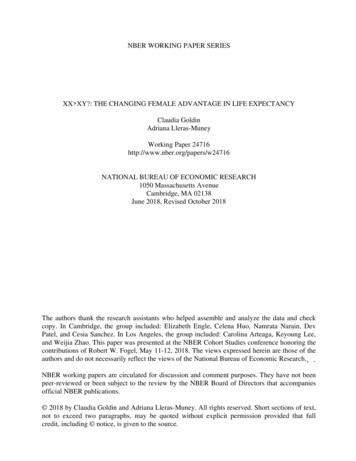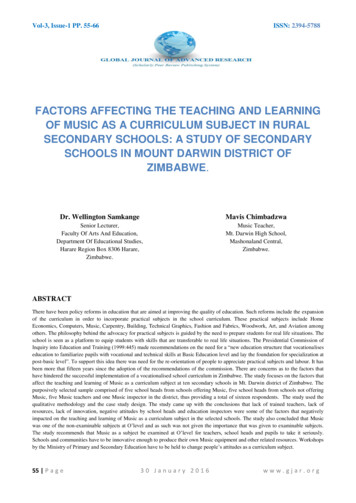
Transcription
UNDER PEER REVIEWFactors Affecting Age Cohorts onLife Cycle Retirement Planning0
UNDER PEER REVIEWABSTRACTThe paper examined effect of age cohort on life cycle retirement planning. A total of 990 questionnaires weredistributed with a 55.2% return rate. Four hypotheses were analysed using hierarchical and ordinary regressionanalysis. The results revealed that age cohort variables made significant contribution to life cycle retirementplanning, particularly the younger age cohort. Current financial resources do have a strong positive impact onconsumption for all age cohorts. On the other hand, no significant effect was found between age cohorts andcurrent financial resources but older age cohorts were relatively more significant predictors. The implication wasthat not only should their individual perceptions of retirement planning become an increasingly important part ofpeople’s long-term commitment throughout their life-cycle, it must also assume the role as a self-directed lifelong learning process, in view of the ever-changing and complicated financial environment. Consumption patternwould have reduced post retirement. During their retirement years, healthcare will become ever so important asthe elderly cohorts will have different degrees of health, illness, and disability. This can translate to higher costwithin the same age cohort.Keywords: Retirement Planning, Age Cohort, Life Cycle, Financial Resources, Consumption1. INTRODUCTIONThere is a growing trend around the world where the primary responsibility for providing an adequateretirement income has shifted from governments and employers to the individuals. Pension plans are shiftingfrom the defined-benefit form to defined-contribution, in which plan participants must make investment decisions.With longevity increasing, replacing defined pension plans with defined contribution plans are making socialsecurity arrangements less certain. Increasingly, the very complex problem of saving and investing to provide fora secure retirement income is being transferred to the individuals who may not have either the knowledge or thetraining to handle the task.For example, in the US, as a percentage of all private pension plans, the defined contribution plans increasedfrom 66.8 percent to 92.3 percent in 1998 (Lusardi (2006)). The most obvious pitfall in self-retirement planning isthat it shifts all retirement-planning risks – not saving enough, making poor investment choices, outliving savings– to untrained individuals. Even if investors follow the golden rules of investing – saving early and diligently,holding a broadly diversified investment mix, never tapping their savings until retirement – their success can stilldepend largely on the state of the world financial markets. A market meltdown or financial shock near the end oftheir working careers as witnessed in 2009 can wipe out their hard-earned savings and investments. Fallingstock prices, lower interest rates and reduced dividends from previously stalwart companies may also reduceretirees’ monthly income, requiring them to reduce spending or consider new ways to get income out of theirdiminished assets. For all age cohorts, the amount of financial resources they possess influence how much theywill spend over their life cycle (Tan and Folk (2011), Tan et al. (2012)).1
UNDER PEER REVIEWTo be able to retire from active employment, people must have sufficient income to support themselves duringthe post-retirement period. Retirement income in Malaysia comes from a combination of different sources:pension income from the government for the civil service workers and members of the armed forces, and in thecase of employees in the private sector, savings via withdrawals from the Employees Provident Fund (EPF),personal savings and investments, and support from family members. Previous studies of people in their fiftiesand early sixties have found that savings levels are insufficient and are not in congruent with their expectedretirement age (Bernheim and Scholz (1993), Lusardi (1999)). In many Asian countries, the commitment tofamilial support of the elderly has been found waning. In Japan, South Korea, and Taiwan, the percentage ofelderly living with their children has declined substantially in recent years (Feeney and Mason (2001)).In countries where social security provisions create strong incentives to retire, the retirement age mayeffectively be fixed, so that longer life spans lead to longer periods of retirement and greater pre-retirementsavings. Social security rules in OECD countries create powerful financial incentives to retire at a particular ageand that many workers appear to response to these incentives. In Taiwan, covered workers are eligible uponretirement to receive a lump sum payment based on their contributions to the social security system; the rulesset an incentive for workers not to extend their working careers past 65.Two factors determine the retirement span – the retirement age and life expectancy. In a life-cycle savingscontext, retirement age determines the period for saving and for dissaving. Retirement age is important as itdetermines the duration of a person’s working life and therefore how many years he has to earn income andbuild up the financial security for the future. This in turn determine the duration of the post-retirement period andthe number of years the person will need to finance himself after his retirement. The increase in the retirementspan among Malaysians reflects improved life expectancy – the typical Malaysian retiring today at 60 years oldwill spend almost 20 years in retirement. The individual’s responsibility for retirement security includes making anaccurate estimate of one’s life span, apart from other important factors such as – retirement investment returns,future expenses in later years, and increases in the cost of living and cost of healthcare. Therefore, people facethe prospect of having to support themselves for a long time on their accumulated retirement assets.This paper has examined the extent Malaysians make financial preparations and their readiness for retirement,and the impact of expected retirement age on their retirement planning preparation. A financial planning modelderived from the life-cycle theories was tested, outlining personal demographics such work status, education,household composition, and income variables as life-cycle factors affecting the expectation and planningoutcomes. Outcomes included financial literacy, retirement age, expected sources of retirement income, financial2
UNDER PEER REVIEWplanning commencement, the propensity to save and investment strategies applied. This study further examinesthe issue by means of a cohort analysis to examine whether belonging to a particular group who engaged inretirement planning and having higher level financial literacy make a difference in attitude toward retirement andsecuring financial success in the post-retirement period among Malaysians.Social security in MalaysiaThere is a growing trend around the world where the primary responsibility for providing an adequate retirementincome has shifted from governments and employers to the individuals. Pension plans are shifting from thedefined-benefit form to defined-contribution, in which plan participants must make investment decisions. Withlongevity increasing, replacing defined pension plans with defined contribution plans are making social securityarrangements less certain. Increasingly, the very complex problem of saving and investing to provide for asecure retirement income is being transferred to the individuals who may not have either the knowledge or thetraining to handle the task.Malaysia’s population, which is 28.30 million in 2010 (Department of Statistics, Malaysia (2018)) is expected togrow to about 41.5 million by year 2040. The current median age is 26.3 years. In term of age structure, thepresent population is still considered “youthful”. However, with regard to the aged population (65 years andolder), there has been a clear trend towards an ageing population in Malaysia. The proportion of aged populationis currently at 5.1 percent in 2010 compared to 3.7 percent in 1980. Given prevailing demographic trends, it isprojected that by year 2040, those aged 65 and above will constitute about 14.5 percent (Table 1) of anestimated population of 41.5 million. In terms of absolute numbers, the population of older persons will increasefrom about 1.4 million in 2010 to 6.0 million by the year 2040. This represents a more than four-fold increasewithin the span of 30 years, or an average increase of 153,000 older persons per year.Table 1 indicates that the percentages of elderly people in the population are increasing whilst the number ofyoung people is proportionately diminishing. Because of this increasing population of elderly people, research onretirement is crucial if Malaysian society is to manage and reduce the burden of poverty among retirees and theelderly population. Some of the demographic changes – rapid reduction in mortality, steady pace of fertilitydecline contributing to the consequent declining family size will impact the elderly persons. The decline in fertilityand mortality levels in Malaysia has been consistent with the rapid economic growth that the country has beenexperiencing. As care for the older persons has traditionally been within the family system, further decline in the3
UNDER PEER REVIEWfamily size would ultimately reduce the number of family numbers available to care for their aged dependents.Care of the elderly within the family system is fast becoming a problem owing to the fact that the extended familystructure is slowly being undertaken by nuclear family. Such problems are compounded as more womenparticipate in the labour market and with increasing mobility of young family members.Table 1: Population Size and Age StructureMalaysia, 1980 – 204019801991200020102040Total Population(million)13.718.523.328.341.5Average AnnualGrowth Rate .927.667.35.118.666.914.576.469.259.248.549.5Age Structure (%)0 – 1415 – 6465 & aboveDependency Ratio (%)Source: Department of Statistics, MalaysiaTenth Malaysia Plan, 2010-2015With social and medical advancements, the average life expectancy in Malaysia has increased – from 47years old in the 1950s to 73 years old for men and from 48.5 years old to 77 years old for women (Department ofStatistics, Malaysia (2018)). Better healthcare, availability of advanced medical technology, improved standardsof living, higher education and literacy, have contributed to this change. In the absence of an old-age socialsecurity scheme in Malaysia, it is critical that people plan for their own financial retirement needs. MoreMalaysians are spending longer times of their lives in the post-retirement period although the retirement age forcivil service had been increased from previously 55 years old to 60 years old. For a long time the retirement agefor the private sector was largely unchanged at 55 years old but effective 1 July 2013, this was increased to 60years old.The World Bank and most social security experts advocate a multi-tier framework of social security to providefor retirement income to the different segments of the population. The Bank had earlier suggested a three-pillarsystem of social security: (1) a publicly managed, unfunded Defined Benefit (DB) pillar which provides a coreretirement income to nearly the entire workforce; (2) a mandatory savings tier and funded Defined Contribution(DC) pillar, designed to ensure that individuals do save for retirement, which would provide a supplement tosocial security; and (3) a voluntary private saving pillar representing income from private savings. The first tier is4
UNDER PEER REVIEWtax or contribution-financed redistributive tier with social insurance principles, designed to alleviate poverty andto provide protection to life-time poor. The second tier is the mandatory savings designed to ensure thatindividuals do save for retirement. The third is a tax-advantaged voluntary savings tier which can be used onlyfor retirement (Asher (2002)). New developments and evidence have led the Bank to suggest a five pillar/tierframework (Holzmann and Hinz (2005)). The five-tier framework added Pillar Zero to provide basic pension orsocial assistance financed from the general budgetary revenues to cater to the lifetime poor in the community.Pillar Four recognizes the role of family, community, physical assets (housing) and post-retirement employment.Malaysia has basically two types of retirement benefit plans: (1) a government pension system which isessentially a Defined Benefit (DB) scheme for the civil servants; and (2) a state-run provident fund, theEmployees Provident Fund (EPF) for employees in the private sector. Research in behavioural economicssuggests a breakdown of will power and self-control and often the lump sum EPF withdrawal is spent too quickly.Figure 1 shows mandatory savings scheme such as the EPF have two phases – accumulation phase during anindividual’s working career and the decumulation phase upon his retirement. In the accumulation phase, the rateof return on the savings accumulated and investments by the individual is important. In the decumulation phase,withdrawals of accumulated balances are drawn down on a “lump sum” basis. In the accumulation phase, therate of return obtained on total balances accumulated by an individual has a crucial role to play. A low rate ofreturn (nominal rate less inflation rate) implies that the final accumulated balances will be low, and vice versa. Inthe decumulation phase, the EPF provides for lump sum withdrawals of the accumulated balances rather thanconverting them to a periodic payment or an annuity (Asher (2002)).Figure 1: Accumulation and decumulation phases of Provident Funds Cumulative Balances AccumulationPhaseDecumulationPhaseWorking PhaseRetirement PeriodWithdrawal AgeSource: Asher (2002)5Time
UNDER PEER REVIEWThe most important source of non-familial support for the elderly in Malaysia is the EPF. The EPF is a nationalprovident fund set up in 1951. The EPF works on a DC formula and both employers and employees in theprivate sector contribute to the EPF at the current rate of 12% and 11% of monthly wages respectively. Uponreaching 50 years old, contributors are eligible and have the option to withdraw up to one third of their totalbalance in their EPF account. The balance of two third in their EPF account may be withdrawn in one lump sumupon reaching the age 55 years old. Individual contributors are permitted to withdraw a portion of his or her EPFcontribution, prior to reaching to 55, for certain reasons. These include buying a house and meeting the medicalcosts of a serious disease. The total balance can be withdrawn in the following instances: death, incapacitationand emigration or attaining the age of 55. Benefits for retirees are linked directly to the contributions made bythem and their employers during the period of employment, and the compounded annual dividend declared bythe EPF. As a result, relatively highly-paid workers who pay more into their EPF accounts would have higherretirement accumulations than those who earn less and consequently pay less into their EPF accounts.Research in behavioural economics suggests a breakdown of will power and self-control and often the lump sumEPF withdrawal is spent too quickly. EPF lump-sum retirement benefits were found by the majority of retirees tobe inadequate to sustain life after retirement; in most cases the benefits were exhausted within three years ofreceipt at age 55 (Beattie (1998)).Table 2 shows the average savings of EPF members at 54 years of age, one year before entitlement to fullwithdrawal, is about RM106,000 (US 25,238). With more than 90 percent of the country’s total labour forceemployed in the private sector, this exclusive reliance on mandatory savings pillar in the private sector throughthe EPF results in the consequent lack of protection against longevity and inflation risks, lack of survivors’benefits, and inadequate replacement rates even at the time of retirement. This arrangement has also beenfound to be particularly discriminatory against women.Women as a group have lower exposure to labourforce during their lifetime, and when they do, they as a group earn less than men and tend to live longer thanmen, and would require greater resources in old age. An important characteristic of retirement financingarrangements in Malaysia has been reliance on family, especially children. However, lower fertility rates,industrialisation, urbanisation, changing attitudes and values, expectations leading to more individualistic lifestyleare gradually undermining this reliance.6
UNDER PEER REVIEWTable 2: Average Savings of EPF members at 54 years of ageYear20132014201520162017Active MembersNo. of MembersAverage 82,332204,28884,777213,852Inactive MembersNo. of MembersAverage 75,63784,51389,393106,003Source: EPF Annual Report 20172. LITERATURE REVIEWStudies of retirement preparedness typically assume that people will retire at a fixed age. Earlier-thanexpected retirement has been associated with adverse health and labour market shocks (Anderson et al. (1986),Disney and Tanner (1999), Loughran et al. (2001)). Barring injury or illness, the timing of retirement can be amatter of choice; workers can choose to when to retire, just as they choose how much to save.The principal theories of saving are the life-cycle hypothesis (Modigliani and Brumberg (1954), Ando andModigliani (1963)), and the permanent income hypothesis (Friedman (1957)). Both of these theories assume thatindividuals and households try to smooth consumption over their lifetimes. The decisive difference between thetwo theories concerns the length of the planning period. For Friedman, this period is infinite, meaning that peoplealso for their descendants unlike the Modigliani-Brumberg version, the planning period is finite meaning peoplesave only for themselves.In the face of labour income fluctuations over the course of life, these theories imply that saving rates will beuneven over the course of life. Basically, the life-cycle saving model assume that individuals live for threeperiods: when young, individuals borrow to finance current consumption, when they reach middle aged, theyrepay the loans taken out in the first half period of their life and save for retirement; when they get old and retire,they consume the assets accumulated in the second period of their life. The life-cycle hypothesis predicts thatconsumption in each period depends on expectations about lifetime income.The literature on savings groups household savings motives into five categories:a) Saving to provide resources for retirement - people save during their working years to finance theirconsumption after retirement. Life-cycle theory predicts that people save more in middle age anddissave in old age after retirement (Modigliani and Brumberg (1954), Horioka (2006)).7
UNDER PEER REVIEWb) Precautionary saving to finance unexpected losses of income – a hedge against uncertainty about thefuture; unemployment or sickness (Carroll (1992) (1997), Hubbard et al. (1995)); liquidity constraintsalso make households increase precautionary saving (Browning and Lusardi (1996)).c) Saving to smooth the availability of financial resources over time to maintain a more stable consumptionprofile (Carroll and Summers (1989), Attanasio and Browning (1995), Skinner (1996)).d) Saving to finance expected large lifetime expenditure, that is “big-ticket” items (durable purchases),target savings (wedding, vacation, education); ande) Saving for bequests – assets to bequeath to children and dependents. Bequests can be accidentalbecause of the uncertainty regarding the date of death (Browning and Lusardi (1996), Davies andPalumbo (2001)), strategic, or reduced consumption.Lusardi (1999, 2006) find that planning has effects on both saving behaviour and portfolio choice. Householdswhose head has not planned for retirement accumulate much less than households whose head has done someplanning. Previous studies have found that many households have limited resources until late in their life-cycle orstart saving very late when it is not possible to accumulate much (Lusardi (2006)). The literature examining thefinancial well being of the baby-boom generation (Bernheim (1993), Moore and Mitchell (2000)) has consistentlyshow that baby boomers are not saving enough to maintain their current levels of consumption into theirretirement years. Moore and Mitchell (2000) conclude that the majority of older households will not be able tomaintain their current levels of consumption into retirement without additional saving.Carroll (1992) reports that uncertainty helps to explain why consumption is highly correlated with income in thecase of young consumers who expect their incomes to increase in the future but do not know by how much.Uncertainty also explains why the older population saves a positive amount as they face a lot of uncertaintyregarding their length of life and health costs. Caroll and Summers (1989) obtained results which suggest thatprecautionary saving may account for a large portion of household wealth.Carroll and Summers (1989) notice that the life cycle profiles of income and consumption tracked each other.Households headed by an individual with low education had a relatively flat profile for both income andconsumption, while households headed by better educated individuals presented more of a hump shape. Carroll(1992) shows that if consumers are sufficiently impatient and their labour income is subject to both permanentand temporary shocks, they set consumption close to income. This model with impatient consumers underlabour income uncertainty has been labeled “the buffer-stock model” of savings, because saving is kept to the8
UNDER PEER REVIEWlowest level compatible with the need to buffer negative income shocks. Carroll’s buffer stock model can providea rationale for the income tracking of consumption that was highlighted by Carroll and Summers (1989).Attanasio and Weber (1989) and Gourinchas and Parker (2002) clarify the role played by age-related changes indemographics and hump-shape age profile of labour income in generating income tracking for relatively youngconsumers. Hubbard, Skinner and Zeldes (1994 and 1995) show how precautionary motives interact with theinsurance properties of social security in the US. Attanasio et al. (1999) investigates the interaction betweendemographics and precautionary savings, and highlighted the correlation between education and income; in theanalysis education matters because of income and demographics age profiles are education/specific. Attanasioand Weber (1993) and Attanasio and Browning (1995) stressed the importance of demographics to explainobserved patterns of consumption life cycle profiles.Deaton and Paxson (1997) and Paxson (1996) suggest that saving rates vary reasonably continuously withage, so that people of similar ages act in similar ways. A number of studies have examined the predictive powerof individual date of retirement expectations and have found that these measures are strong predictors of futureretirement dates (Disney and Tanner (1999), Loughran et al. (2001)). Deviations between expected and actualretirement ages are found to be correlated with wealth and health changes as well as marital transitions (Disneyand Tanner (1999). Maestas (2004) finds that many older workers who returned to work after retiring hadplanned on doing so (Haider and Stephens 2004). Michel et al. (2016) posits the fight against risk factors fordisability and dependency, to identify and target modifiable risk factors. It is always possible to positively modify“intermediate” risk factors, such as health habits (sedentary lifestyle and diet), health behaviours (alcoholconsumption, smoking or other addictions), as well as living and working conditions, and access to healthcare.3. CONCEPTUAL FRAMEWORKThe conceptual framework model is outlined in Figure 2 below. The conceptual model posits that several lifecycle factors affect retirement orientations, expectations and plans: family and work status, social location,household composition, consumption, and current financial resources. The life-course perspective links bothproximal and distal forces to individuals’ lived experiences. In this study, each model component is defined,previous relevant research for each component is summarised, and the hypothesised relationships betweenmodel components outlined below. The life-cycle factors affecting retirement planning are summarised as theyrelate to these retirement outcomes.9
UNDER PEER REVIEWThe age cohort is important for two reasons: the older the retirement age, the more years an individual willhave in the work force, thus increasing the probability of having adequate financial resources for retirement.Longer employment may increase the types and amounts of retirement benefits. Retiring at an older ageincreases the number of years to accumulate savings for retirement; at the same time it reduces the number ofyears spent in retirement. Therefore, the higher the age cohort, the higher is the probability of having adequatefinancial resources for retirement. Early life advantages or disadvantages are recognized as cumulating over thelife course, leading to different later-life experiences.In this study, the relation between preferred and expected retirement age will be examined with reference toretirement plans. Are individuals who plan financially for retirement more likely to have congruence in theirpreferred and planned retirement age? What types of financial plans relate to greater congruence? Confidencein one’s financial preparedness and savings encourages retirement at younger ages. Differences betweenexpected and actual retirement ages may arise due to unforeseen circumstances, such as job redundancy, poorhealth, realization that one is not financially prepared to retire, and mental state of health. The life-courseframework expands beyond consideration of time in an individual’s life course to social and historical time aswell.Figure 2: Conceptual Framework of Age Cohort Effect on Life Cycle Retirement PlanningAge Cohort-Life StagesAge 26 - 35Age 36 – 45Age 46 – 55Age 56 – 64Age 65 Retirement PlanningPreparatory Activities- Assess financial situation- Obtain retirement planning info- Participate in formal retirementplanning programPlan Initiation- Have retirement plans- Age began planningAsset Accumulation- Government resources- Employer resources- Personal-initiated resources- Other resourcesH1H4hh*DemographicsWork & Family *Work StatusOccupationHouseholdComposition *Marital StatusChildrenAgeSocial Location *GenderRaceEducationCurrent FinancialResourcesIncomeDebtH2H3hhExpected Retirement Age3.1 Age CohortA cohort refers to a group of people with unique shared experiences or characteristics. The concept of cohort(Ryder 1965) has been recognised as an important way of assessing the influence of social change and10
UNDER PEER REVIEWhistorical circumstances on individuals (Elder and Caspi 1990). This study examined whether belonging to aparticular age cohort relates to differences in attitudes and financial preparation toward retirement. The six agecohorts are: 26-35, 36-45, 46-55, 56-64, and 65 . By having respondents at different stages of their life-cycle,this study examined the attitude and the general level of preparedness of Malaysians towards preparing for theirretirement – focusing on how Malaysians plan and save for their retirement vis-à-vis the life-cycle theories.Therefore, it is hypothesised that age cohorts have a positive orientation towards retirement financial planning.3.2 Demographics3.2.1 Work and FamilyThe relationship between work and the family are critical factors to financial planning and retirementpreparations. Most people spend a significant part of their adult lives in some form of employment and work.Through their job, people derive and build their value system, personal relationships, self-esteem and financialsecurity. Employed persons are earning income and some are accumulating retirement savings and benefits.Unemployed persons, on the other hand, have to resort to living off their savings from past earnings, supportfrom family members or to seek assistance from state social and welfare assistance. The accumulative effect ofprolonged unemployment is lower or no retirement savings and income. Time spent out of the labour market thatis devoted to marriage, family life, childbearing, caring for sick family members, and as a homemaker, impactfinancial planning for retirement due to discontinuity in work and income. Family responsibilities andcommitments may involve work decisions such as choosing to work part-time to be able to spend more time withfamily. This is particularly critical in the case of female members of the family who typically assume moreresponsibility for caring for the family – giving up their own career opportunities to devote to their spouse ashomemaker after marriage, devoting their time to look after their children and often times as caregivers to theelderly members of their family. These sacrifices can therefore undermine their own career advancements and inturn reduce their lifetime earnings, retirement savings, and financial independence.3.2.2 Household CompositionAnother demographic factor which is important for saving behaviour is the composition of the household.Compared to unmarried individuals, married couples report greater average wealth, more than remarriedcouples and singles. Since children increase household
A financial planning model derived from the life-cycle theories was tested, outlining personal demographics such work status, education, household composition, and income variables as life-cycle factors affecting the expectation and planning outcomes. Outcomes included financial literacy, retirement age, expected sources of retirement income .









![05[2] Strategy competitors, competitive rivalry .](/img/2/052-strategy-competitors-competitive-rivalry-competitive-behavior-and-competitive-dynamics.jpg)
